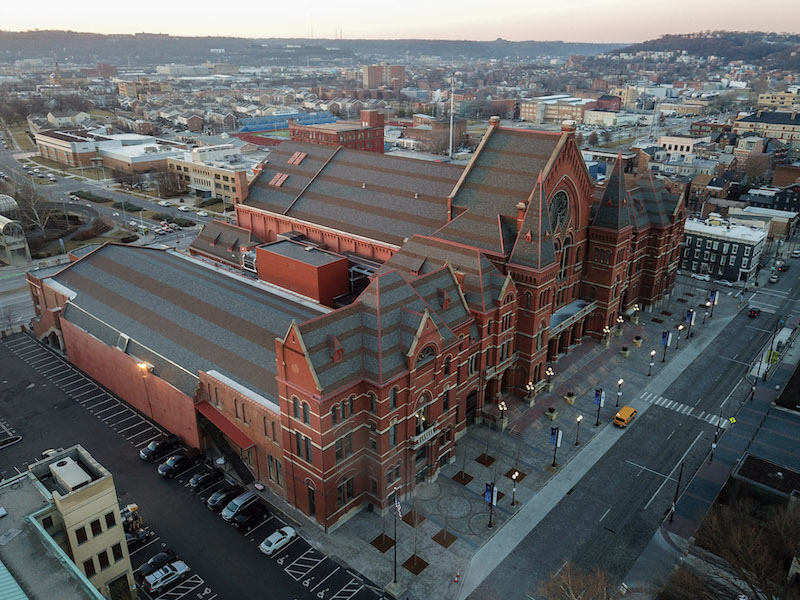A Cincinnati landmark with a rich and unique history recently received a total facelift, restoring the facility to the grandeur it displayed when it opened 140 years ago.
Workers tackled a 16-month, $143-million project at Cincinnati Music Hall, and finished the project last October. Music Hall, which is the home of the Cincinnati Symphony Orchestra and several other cultural organizations, reduced seating capacity at Springer Auditorium from 3,417 to 2,263-2,2524, depending on the configuration. The project included updates to the roof, exterior, Edyth B. Lindner Grand Foyer, Corbett Tower, Library and Ballroom. In all, the project added 31,549 square feet in the same footprint.
“We’ve been in business since 1880 and take pride in our work on many of the iconic buildings in Cincinnati,’’ said Andrew Imbus, Project Manager at Imbus Roofing of Wilder, Kentucky. “This is a project that we are going to be proud of for a very long time.”
Music Hall, which was recognized in January 1975 as a National Historic Landmark by the U.S. Department of the Interior, also serves as the home of the Cincinnati Opera, Cincinnati Pops Orchestra and May Festival Chorus.
One of the most challenging assignments in the major remodeling effort was the roof. Imbus and his team had installed the previous roof in 1988. “It was worn, but still water tight,’’ Imbus said. “Some shingles were starting to blow off.”
 The project included seven BILCO double-leaf hatch smoke hatches that will exhaust smoke and hot gases in the event of a fire to aid emergency evacuation and to protect the building contents.
The project included seven BILCO double-leaf hatch smoke hatches that will exhaust smoke and hot gases in the event of a fire to aid emergency evacuation and to protect the building contents.
Imbus’ first charge was to find replacement shingles that mirrored those of the past roof to preserve the historical appearance of the building. The roof also required new double leaf smoke hatches, manufactured by The BILCO Company of New Haven, Connecticut. Imbus’ team installed seven DSH Automatic Smoke Vents. The vents, which measure 66 inches by 144 inches, are among the largest smoke hatches on the commercial market.
The smoke vents include a Thermolatch® II positive release mechanism that ensures reliable vent operation when a fire occurs. The vents automatically release upon the melting of a UL-listed 165F fusible link, and a curb-mounted fusible link allows the latch to be easily re-set from the roof level. The vents are fully insulated and gasketed for weather tightness.
The vents are hard-wired to the fire suppression system and open electronically if the sprinkler system activates. Corken Steel, the local distributor of the smoke vents, and BILCO rep Joe DeFrain of Welling, Inc., worked with Imbus in procuring the roof hatches. The vents were installed above the main hall, Springer Auditorium, and are designed to open in an emergency to allow smoke and hot gases to escape. This allows better visibility and breathing conditions for audience members and performers to evacuate safely and aid firefighters in their containment efforts.
Perhaps the centerpiece to the improvements occurred at Springer Auditorium, where accessibility and sightlines were improved. The seats increased in width size and the distance between rows also increased. In addition, the renovations made the building compliant with the Americans with Disabilities Act, with increased wheelchair accessible seating in prime locations, and easier movement between floors.
“This was an important project for Cincinnati,’’ said Joe DeFrain, a BILCO representative with Welling, Inc. “It’s part of a revitalization of the entire community. Everyone in Cincinnati knows the Music Hall. We’re a third generation, family-owned company from Cincinnati, and we’re proud to have been a part of it.”
Related Stories
| Aug 11, 2010
Suffolk Construction Company acquires William A. Berry & Son
Suffolk Construction Company, New England’s largest construction company announced today that they have acquired William A. Berry & Son (Berry), the second largest construction company in the region. The two companies, both with deep New England roots and successful track-records, combined will have more than 1,200 employees and projected revenues of $2 billion.
| Aug 11, 2010
Toronto mandates green roofs
The city of Toronto late last month passed a new green roof by-law that consists of a green roof construction standard and a mandatory requirement for green roofs on all classes of new buildings. The by-law requires up to 50% green roof coverage on multi-unit residential dwellings over six stories, schools, nonprofit housing, and commercial and industrial buildings.
| Aug 11, 2010
Great Solutions: Green Building
27. Next-Generation Green Roofs Sprout up in New York New York is not particularly known for its green roofs, but two recent projects may put the Big Apple on the map. In spring 2010, the Lincoln Center for the Performing Arts will debut one of the nation's first fully walkable green roofs. Located across from the Juilliard School in Lincoln Center's North Plaza, Illumination Lawn will consist ...
| Aug 11, 2010
Nurturing the Community
The best seat in the house at the new Seahawks Stadium in Seattle isn't on the 50-yard line. It's in the southeast corner, at the very top of the upper bowl. "From there you have a corner-to-corner view of the field and an inspiring grasp of the surrounding city," says Kelly Kerns, project leader with architect/engineer Ellerbe Becket, Kansas City, Mo.
| Aug 11, 2010
AIA Course: Enclosure strategies for better buildings
Sustainability and energy efficiency depend not only on the overall design but also on the building's enclosure system. Whether it's via better air-infiltration control, thermal insulation, and moisture control, or more advanced strategies such as active façades with automated shading and venting or novel enclosure types such as double walls, Building Teams are delivering more efficient, better performing, and healthier building enclosures.







